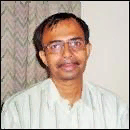
Santanu Das
Work place: Department of Electronics & Telecommunication Engineering, Indian Institute of Engineering Science & Technology, Shibpur, Howrah -711103, India
E-mail:
Website:
Research Interests: Computational Engineering, Engineering
Biography
Santanu Das was born in 1968. He received the B.E. degree in Electronics and Telecommunication Engineering from Bengal Engineering College of Calcutta University (India) in 1989 and M.E. degree in Microwave Engineering from Jadavpur University, Calcutta, in 1992. He obtained Ph.D. (Engineering) degree from Jadavpur University in 1998. He joined the Indian Institute of Engineering Science & Technology, Shibpur (Formerly Bengal Engineering and Science University), India in the year 1998, as a Lecturer in the Dept. of Electronics and Telecommunication Engineering and presently holds the post of Professor. His current research interests include microstrip circuits, FSS, antenna elements and arrays. He is a life member of the Institution of Engineers, India (IE).
Author Articles
Design of an UWB Bandpass Filter Using Dual MMR with Highly Attenuated Upper Stopband Using DGS
By Aditi Sengupta Somdotta Roy Choudhury Santanu Das
DOI: https://doi.org/10.5815/ijwmt.2018.03.06, Pub. Date: 8 May 2018
A miniature sized microstrip UWB (ultra wideband) BPF (bandpass filter) having highly attenuated upper stop band performance using a dual MMR (multimode resonator) and the DGS (defected ground structure) is proposed. Combining these two topologies, a prototype of the proposed UWB BPF is fabricated using FR-4 substrate of 1.6 mm thickness with dielectric constant of 4.4. This BPF is modelled and simulated using Ansoft high frequency structure simulator (HFSS) Software. The simulated and measured results show a wide FBW (fractional bandwidth) of 119% .The insertion loss is less than -1.0 dB throughout the pass band of 2.78 to 10.95 GHz. All the ripples of return loss are lower than -14 dB in the passband. The BPF has a high rejection of more than -30 dB in the upper stop band up to 16.8 GHz. The simulated and measured group delays variation in the passband are found to be less than 0.2 ns. The overall length of the resonator is 7 mm.
[...] Read more.Other Articles
Subscribe to receive issue release notifications and newsletters from MECS Press journals